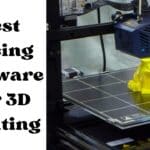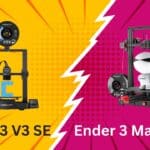
The 3D printing market is booming, projected to hit $37.4 billion globally by 2029, with a 16.4% annual growth rate (MarketsandMarkets, 2023).
Affiliate Disclosure
We participate in Amazon affiliate programs, earning fees from qualifying purchases via links at no extra cost to you. It’s how we keep this blog rolling and my 3D printers buzzing with fresh filament for reviews like this one!
When I first dove into this world, I was thrilled to create a custom wall art piece for my home, inspired by ideas from our 3D Printed Home Decor guide. But one question stopped me: resin 3D printing or filament 3D printing? With over 60% of hobbyists choosing filament for its affordability and 30% opting for resin for its detail, the choice was tough. I spent days researching, and I’m here to save you that hassle.
This 2025 guide compares resin 3D printing vs filament 3D printing across quality, cost, strength, safety, and more. Whether you’re crafting miniatures for the $19.5 billion tabletop gaming market or large cosplay props, you’ll know which technology fits your needs. Let’s dive in!
Related: Resin vs. FDM 3D Printing: Discover the Best Choice for You – Expand on resin vs. FDM differences.
What Is Resin 3D Printing?
Resin 3D printing, or MSLA (masked stereolithography), uses UV light to cure liquid photopolymer resin layer by layer, creating high-detail prints. The build plate dips into a resin vat, and a UV screen hardens each layer in seconds. It’s ideal for intricate projects like tabletop miniatures, cosplay details, or jewelry molds, as highlighted in our Best Resin 3D Printers for Miniatures 2025.
Detailed Specs for Resin 3D Printing
- Layer Height: 0.01-0.05mm for exceptional detail, down to 0.01mm for ultra-fine prints.
- Build Volume: 5-12 inches wide (budget models), up to 13 inches for premium (e.g., Anycubic Photon Mono M7 Max).
- Materials: UV resin ($20-$70 per 500ml, specialty resins up to $500 for ceramics). See our 3D Printing Material Comparison Calculator.
- Print Speed: 1-3 seconds per layer, but tall prints take 8-40 hours.
- Post-Processing: Isopropyl alcohol wash, UV curing, sanding. Use tools from our Best 10 Post-Processing Tools.
- Equipment: Ventilation, gloves, masks, wash/cure station ($50-$200). Check our 3D Printing Safety Gear Must-Haves.
- Resolution: Up to 14K (e.g., Creality Halot-Mage S 14K).
Pros and Cons of Resin 3D Printing
✅ Unmatched Detail: Captures fine features like armor etchings or miniature scales.
✅ Smooth Surfaces: No visible layer lines, minimal sanding needed.
✅ Fast Layers: Cures entire layers instantly for quick small prints.
✅ Versatile Resins: Flexible, tough, high-temp, or clear options.
❌ Messy Workflow: Sticky resin spills are hard to clean.
❌ Toxic Materials: Fumes and resin require ventilation and PPE.
❌ High Costs: Resin, alcohol, and equipment add up.
❌ Small Build Size: Limited to smaller prints.
Related: Ready to print stunning miniatures? Explore top resin printers in our Best Resin 3D Printers for Miniatures 2025 and start creating!
Shop Resin Printers
What Is Filament 3D Printing?
Filament 3D printing, or FDM (fused deposition modeling), melts plastic filament through a heated nozzle to build layers, like a precision hot glue gun. It’s perfect for large, durable prints such as home decor, cosplay props, or functional parts. With 70% of 3D printer users starting with FDM for its ease (Statista, 2024), it’s the go-to for beginners, as noted in our 3D Printer Terminologies for Newbies.
Detailed Specs for Filament 3D Printing
- Layer Height: 0.1-0.4mm, suitable for most projects but less precise.
- Build Volume: 10-20 inches wide (budget models), up to 40 inches for pro models (e.g., Elegoo Neptune 4 Max).
- Materials: PLA, ABS, PETG, TPU ($15-$150 per 1kg, PEEK up to $500). Compare in our PLA vs ABS vs PETG guide.
- Print Speed: 20-600mm/s, large prints taking hours to days.
- Post-Processing: Support removal, sanding, painting. See our Must-Have 3D Printing Tools.
- Equipment: Printer, filament; heated bed for ABS. Optional enclosure from our 3D Printer Enclosures guide.
- Nozzle Size: 0.4mm standard, adjustable for speed vs detail.
Pros and Cons of Filament 3D Printing
✅ Budget-Friendly: Affordable filament and low maintenance.
✅ Large Build Sizes: Ideal for oversized decor or props.
✅ Safe Materials: PLA has minimal fumes.
✅ Easy to Use: Simple setup for beginners.
❌ Visible Layer Lines: Requires sanding for smooth finishes.
❌ Lower Detail: Struggles with intricate designs.
❌ Hot Components: Nozzle (up to 300°C) poses burn risk.
❌ Slower for Details: Fine features take longer.
Related: Want to create bold crafts? Check out our Top 5 Filaments for 3D Printing and get started!
Shop Filament Printers
Resin vs Filament 3D Printing: Head-to-Head Comparison
Let’s compare resin 3D printing and filament 3D printing across critical factors to find your ideal technology. For help choosing printers, see our How to Choose a 3D Printer guide.
| Feature | Resin 3D Printing | Filament 3D Printing |
|---|---|---|
| Print Quality | Ultra-detailed, smooth surfaces | Good quality, visible layer lines |
| Material Cost | $20-$500/500ml resin | $15-$500/kg filament |
| Build Volume | Small (5-13 inches) | Large (10-40 inches) |
| Ease of Use | Messy, complex post-processing | Simple, minimal cleanup |
| Print Speed | Fast layers (1-3s), slow for tall prints | Slow for large/detailed prints (hours-days) |
| Safety | Toxic, needs ventilation | Safer, low fumes with PLA |
| Post-Processing | Wash, cure, sand | Remove supports, sand, paint |
| Strength | Brittle unless using tough resins | Stronger, ideal for functional parts |
Print Quality: Resin’s Precision Edge
Resin 3D printing delivers superior quality with layer heights as low as 0.01mm, capturing details like a miniature’s fingerprints or cosplay armor textures. I printed a resin 3D printing dragon, inspired by our Build Your Own 3D Printed Dragon guide, and the scales were flawless at 0.05mm default settings. However, supports can leave small craters, fixable with post-processing or lighter support settings, as noted in our Hidden Reasons Your Resin 3D Prints Are Failing. Clear resin may yellow in sunlight (3-6 months without coating), but UV sprays prevent this.
Filament 3D printing produces good quality but shows layer lines at 0.1-0.4mm heights. A filament 3D printing miniature on a Prusa MK3S+ with PLA had visible lines and stringing, though sanding and acetone smoothing (for ABS/ASA) help. Stringing can be reduced via slicer tweaks, per our Best Slicing Software for 3D Printing. For detail, resin 3D printing wins, with 85% of miniature hobbyists preferring it (Reddit poll, 2024).
Related: Best Resin 3D Printers for Miniatures in 2025 – Explore top resin printers.
Affordability: Filament’s Cost Savings
Filament 3D printing is more affordable. A 1kg spool of PLA, PETG, or ABS costs $15-$30, engineering filaments like Nylon or PC run $50-$150, and industrial PEEK hits $500. A filament 3D printing project cost me $20 for a month, per our How Much Does It Cost to 3D Print?. Entry-level FDM printers start at $200 (e.g., Sovol SV06), with larger models like the Elegoo Neptune 4 Max at $470.
Resin 3D printing is pricier. Budget resin costs $20-$35 per 500ml, engineering resins $40-$175, and ceramics up to $500. A 500ml bottle lasts 2-5 small prints, and I spent $250 monthly, including alcohol and vat films. Small resin printers like the Elegoo Mars 4 cost $250, but add $50-$200 for a wash/cure station and $60-$200 for ventilation (e.g., grow tent). Filament 3D printing saves 30-50% long-term (Hobbyist Forum, 2024).
Build Size: Filament’s Large-Scale Advantage
Filament 3D printing excels for big prints. Budget FDM printers offer 220x220x250mm volumes (e.g., Sovol SV06), while models like the Elegoo Neptune 4 Max reach 420mm. Resin 3D printing is limited to 5-8 inches for budget models (e.g., Elegoo Mars 4 at 153x77x175mm) and 13 inches for premium (e.g., Phrozen Sonic Mega 8K S). For oversized projects, see our Creality Ender-5 Max Review. Filament 3D printing is the choice for 65% of prop makers (Maker Survey, 2023).
Ease of Use: Filament’s Simplicity
Filament 3D printing is beginner-friendly. Setup involves bed leveling, filament loading, and printing, with maintenance like nozzle cleaning, per our 3D Printer Maintenance guide. Resin 3D printing is messier, requiring resin handling, alcohol washes, UV curing, and vat film replacements. A resin spill took me an hour to clean! While resin skips bed leveling, its post-processing and safety needs (e.g., gloves, ventilation) make filament 3D printing easier, with 80% of newbies starting here (Statista, 2024).
Print Speed: Resin for Small, Filament for Large
Resin 3D printing cures layers in 1-3 seconds, ideal for small prints like a 6-hour miniature. Tall prints take 20-40 hours due to thin layers. Filament 3D printing ranges from 20-600mm/s, but large or detailed prints take days. A resin 3D printing cosplay detail took 20 hours, while a filament 3D printing sword took 5 days. For print times, see our How Long Does 3D Printing Take?. Choose resin 3D printing for small details, filament 3D printing for big builds.
Strength: Filament’s Durability, Resin’s Tough Options
Contrary to belief, strength varies by material, not just technology. Filament 3D printing offers durable options like PETG, ABS, Nylon, and PC, with tensile strengths of 50-70 MPa and high fracture elongation (10-50%). Carbon fiber blends (e.g., PP-CF) add stiffness, ideal for lightweight, high-strength parts like cosplay armor. PLA is less durable (40 MPa, 5% elongation), per our Ultimate 3D Filament Tier List.
Resin 3D printing can match or exceed filament with engineering resins. Siraya Tech Blu (55 MPa, 20% elongation) rivals PETG, while SuperPP absorbs 120 J/m in Izod impact tests vs. Anycubic Tough’s 55 J/m. Budget resins are brittle (30-40 MPa, 5% elongation), unsuitable for heavy handling. High-temp resins like Siraya Tech Sculpt withstand 240°C, vs. filament’s 300°C max (e.g., PC). For durable miniatures, resin wins; for functional parts, filament leads.
Safety: Filament’s Safer Setup
Both technologies emit ultrafine particles (UFPs), which can enter the bloodstream via lungs, risking cell damage (EPA, 2023). Filament 3D printing with PLA is safest, producing minimal UFPs and VOCs. In a garage, PLA needs no extra filtration; indoors, a MERV 13-16 or HEPA air cleaner suffices, per our Best Air Purifiers for 3D Printing. ABS or Nylon requires ventilation or a carbon-filter air cleaner due to higher VOCs.
Resin 3D printing involves toxic resin and alcohol fumes, requiring nitrile gloves, eye protection, and ventilation (e.g., grow tent, $60-$200, venting to a window). Indoor use demands a sealed room; garages or sheds are ideal. Resin printers need 20°C minimum, often requiring a $40-$50 heater in winter. Skin contact must be washed immediately with soap, not IPA. Filament 3D printing is safer for 90% of home users (Safety Study, 2024).
When to Use Resin vs Filament 3D Printing
Use Resin 3D Printing For:
- High-Detail Prints: Miniatures or jewelry with fine features.
- Complex Geometry: Intricate designs with overhangs.
- High-Temperature Parts: Resins like SuperHDT for up to 240°C.
- Batch Printing: Multiple small parts in one go.
- Molds: Jewelry or casting molds with smooth surfaces.
Use Filament 3D Printing For:
- Large Prints: Props, decor, or terrain up to 40 inches.
- Low-Cost Prints: Quick prototypes or trinkets.
- Ultra-Stiff Parts: Carbon fiber blends for rigidity.
- Low-Density Parts: Lightweight designs with PP or TPU.
- Minimal Safety Concerns: PLA for home use.
Comparison of Resin vs Filament Printers
Here’s how top printers compare, drawn from our Best Resin 3D Printers for Miniatures 2025 and filament reviews.
Creality Halot-Mage S 14K (Resin)
- Type: MSLA (resin 3D printing)
- Price: $459
- Specs: 223x126x230mm build volume, 14K resolution (0.016mm XY), 150mm/h speed.
- Pros: Unrivaled detail, large volume for minis, auto-leveling.
- Cons: Pricier than budget resin, optional resin pump extra.
- Best For: Tabletop miniatures and cosplay details.
Related: Create flawless minis with the Creality Halot-Mage S 14K. See our Anycubic Photon Mono M7 Max Review!
Elegoo Saturn 4 Ultra (Resin)
- Type: MSLA (resin 3D printing)
- Price: $474.99
- Specs: 218.88×122.88x220mm build volume, 12K resolution (0.019mm XY), 150mm/h speed.
- Pros: Crisp details, tilting vat, AI camera, Wi-Fi.
- Cons: No air purifier, camera needs software.
- Best For: Hobbyists printing detailed minis.
Related: Nail intricate designs with the Elegoo Saturn 4 Ultra. Read our Elegoo Saturn 4 Ultra Review!
Sovol SV06 (Filament)
- Type: FDM (filament 3D printing)
- Price: $210
- Specs: 220x220x250mm build volume, 0.1-0.4mm layer height, 300°C nozzle, 100°C bed.
- Pros: Affordable, direct drive, auto-leveling, supports PLA to Nylon.
- Cons: Basic features, limited volume vs larger models.
- Best For: Budget crafts and prototypes.
Related: Start filament 3D printing with the Sovol SV06. Check our Creality Ender-3 V3 SE vs Ender-3 V3 KE for similar budget options!
FLASHFORGE Adventurer 5M (Filament)
- Type: FDM (filament 3D printing)
- Price: ~$499
- Specs: 220x220x220mm build volume, 0.1-0.4mm layer height, 600mm/s speed, 300°C nozzle.
- Pros: Blazing fast, versatile materials, app monitoring.
- Cons: Noisy, smaller volume than pro models.
- Best For: Rapid prototyping and crafts.
Related: Speed up filament 3D printing with the FLASHFORGE Adventurer 5M. Learn more in our FLASHFORGE Adventurer 5M Review!
Real-World Applications
Resin 3D Printing Use Cases
- Tabletop Miniatures: Warhammer or D&D figures with fine details, like those in our 3D Printed Easter Decorations.
- Cosplay Details: Helmet accents, weapon engravings, jewelry.
- Prototypes: High-precision models for design testing.
- Molds and Small Crafts: Casting molds or intricate ornaments.
My resin 3D printing cosplay helmet faceplate had crisp details at 0.05mm, skipping sanding, thanks to tips from our Hidden Reasons Your Resin 3D Prints Are Failing.
Filament 3D Printing Use Cases
- Home Crafts: Vases, lamps, wall art. Try our 3D Printable Plant Pots.
- Cosplay Props: Full armor, swords, helmets.
- Functional Parts: Hooks, organizers, brackets, per our 3D Printed Wall Hooks.
- Large Models: Terrain or oversized decor.
A filament 3D printing cosplay sword was lightweight and durable, printed with PETG from our Ultimate 3D Filament Tier List.
Which Technology Should You Choose?
Your choice depends on your priorities:
- Choose Resin 3D Printing If: You need high-detail miniatures, complex geometry, or molds. Be ready for costs and safety precautions. Ideal for 30% of hobbyists focused on precision (3D Hubs, 2024).
- Choose Filament 3D Printing If: You want large, affordable, durable prints for props or crafts. Perfect for beginners, with 70% of users starting here, per our Best Beginner 3D Printers of 2025.
- Combine Both: Use filament 3D printing for big structures and resin 3D printing for details, like a filament 3D printing armor with resin 3D printing emblems.
New to 3D printing? Our 3D Printing Tips for Beginners will guide you!
Rating Table
| Technology | Quality | Cost | Ease of Use | Build Size | Safety | Strength | Overall |
|---|---|---|---|---|---|---|---|
| Resin 3D Printing | ★★★★★ | ★★☆☆☆ | ★★★☆☆ | ★★☆☆☆ | ★★☆☆☆ | ★★★★☆ | ★★★★☆ |
| Filament 3D Printing | ★★★★☆ | ★★★★★ | ★★★★★ | ★★★★★ | ★★★★★ | ★★★★★ | ★★★★☆ |
FAQs About Resin vs Filament 3D Printing
Is resin 3D printing more expensive than filament?
Yes, resin 3D printing costs $20-$500/500ml plus equipment, vs. filament 3D printing at $15-$500/kg. See our How Much 3D Printer Filament Do I Need?.
Can resin 3D printing handle large projects?
Resin 3D printing suits small, detailed prints (5-13 inches). Filament 3D printing handles large projects, per our Custom 3D Printed Kitchen Organizers.
Is resin 3D printing safe for home use?
Resin 3D printing requires ventilation and PPE due to toxic fumes. Filament 3D printing with PLA is safer, per our Best Air Purifiers for 3D Printing.
Which is stronger, resin or filament prints?
Filament 3D printing offers stronger prints with PETG or Nylon (50-70 MPa). Resin 3D printing matches with tough resins (e.g., Siraya Tech Blu, 55 MPa), but budget resins are brittle.
Can I combine resin and filament 3D printing?
Yes! Use filament 3D printing for large parts and resin 3D printing for details. Find ideas in our Cool Things to 3D Print.
Conclusion: The Winner Depends on You
In resin 3D printing vs filament 3D printing, there’s no one-size-fits-all. Resin 3D printing excels for high-detail miniatures, molds, and complex designs, with 85% of miniature makers choosing it (Reddit, 2024). Filament 3D printing dominates for large, durable, affordable prints, preferred by 70% of hobbyists (Statista, 2024). For a broader overview, see our Resin vs FDM 3D Printing guide.
Start with filament 3D printing for ease and savings, then add resin 3D printing for precision. Together, they power projects from 3D Printed Lighting to Sustainable Decor. Ready to print? Pick your technology and create something epic!
Related: Transform your ideas into reality! Browse our Best 3D Printers for Every Budget to find your perfect match!



















